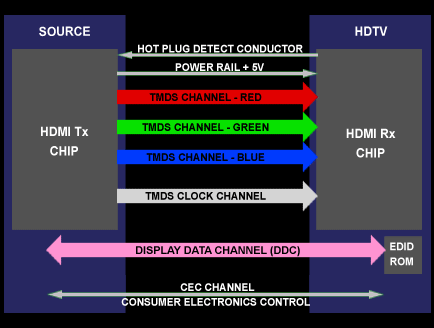In the beginning, HDMI was the ideal interconnect for sending and receiving digital audio/video signals to and from the components in a single Home Theater System. HDMI signal distribution to remote locations, using very long cable runs was not carefully considered. As we all know, longer cables increase electrical capacitance which attenuates signals…not a good thing with high-speed, high-bandwidth digital information. So, with the many enhancements to HDMI v1.3 products now available, it is very important to understand how to deal with long cable runs for satisfactory performance.
HDMI signals are carried through a cable with 19 discrete conductors. Two of those conductors represent the Display Data Channel (DDC) which is sometimes referred to as the I2C bus (see diagram). The DDC supplies the HDMI source with the TV’s Extended Display Identification Data (EDID) which is stored in the display’s ROM …basically the display’s resolution capabilities along with other vital audio/video information the source needs. The DDC is bi-directional and also manages the HDCP “handshake” or key exchange that happens every 2 seconds as part of the authentication process between the source and the display. Signal attenuation caused by capacitance in long cable runs can adversely affect the exchange of critical DDC data causing erratic performance or in some cases, no picture or audio at all.
Our new 1391A Extender/Corrector solves signal attenuation problems in HDMI applications where long cable runs are employed. The 1391A has an Adjustable Equalization circuit that helps overcome potential signal timing/delivery issues.
It also has DDC correction circuitry which helps condition the I2C bus to prevent data loss due to capacitance. This correction circuitry is extremely important for proper HDCP authentication in long cable runs. Finally, the 1391A is powered by an external power supply, which preserves the critical +5 volt rail so essential to stable performance in HDMI systems.
| | 
TMDS is "Transition Minimized Differential Signaling" which is the “pathway” for carrying digital video and audio signals, plus other needed data from point-to-point in digital circuits. There are 3 TMDS modes or channels of signal information sent in HDMI transmissions, plus a TMDS Clock to govern the speed or rate of the signals so that there are no timing or synchronization problems.
CEC means "Consumer Electronics Control" and is a one-conductor, bi-directional, serial bus that allows a person to control multiple CEC enabled devices with a single remote control. It also allows a CEC enabled device to control other CEC devices without any user action.
HDCP is an acronym for "High-bandwidth Digital Content Protection" which is an encryption process embedded in source material used to protect digital material from being perfectly copied. HDCP was approved for use by the FCC in August 2004 to protect the rights of authors, artists, and moviemakers under the auspices of Digital Rights Management (DRM), and the Digital Millenium Copyright Act.
|

